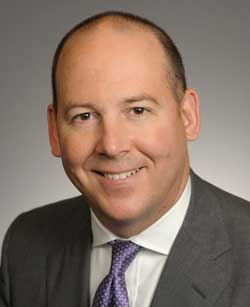State Street’s new head of IR talks about Basel III, widening the investor base and training up IR interns
Anthony Ostler’s appointment as the new head of investor relations at State Street marks the Canadian national’s fourth spell in IR – spread across a finance career spanning 22 years. In his previous IR incarnations, Ostler has been a part of an IR Magazine Award-winning team at RBC, helped take Canaccord Capital public on Toronto Stock Exchange and the Alternative Investment Market, and turned around analyst ratings at Manulife.

Anthony Ostler, State Street
‘When I arrived there were only two buys on the stock and by the time I moved out of IR in early 2013, the number of buys on the stock [had increased] to 12,’ says Ostler, adding that ‘the IR program at Manulife was ranked 54th in Canada by IR Magazine when I arrived and the ranking had increased to seventh place by the time I moved on’.
This impressive IR resumé puts Ostler in good stead to lead the five-strong investor relations team at Boston-headquartered State Street. Despite this, he acknowledges some challenges to his new role, such as ‘a significant learning curve to get up to speed on what Basel III means to State Street and the various implications of all of the financial services regulatory reform that has been implemented’, as well as prepping for the company’s next investor day in February 2015.
‘My goal is to be in a position by investor day to help enhance how we present our strategy and businesses to the Street,’ he says.
How would you describe your approach to IR in three words?
Strategic, objective and empathetic.
What is your marketing plan at State Street?
I’ve only been here a month but I think you can always be doing more. My focus is on fine-tuning the strategy to target potential investors while being more strategic in our communications. Part of [the plan] is to get a better feel of the overall investor base. This means analyzing our current shareholders and finding where there are opportunities to attract new ones. While there is significant overlap, there are also some gaps and I’m looking at why those gaps exist and where on our communications and narrative we need to improve. Specifically, two of the opportunities I see are among international and retail investors.
How is State Street’s investor base made up?
We’re in the S&P 500 and, as you might expect, our investor base is heavily institutional and includes a lot of passive exchange-traded funds. We have very few retail investors, primarily because we’re not a retail business so we don’t have the same name recognition as a retail bank. It’s also significantly biased toward the US – likely because we’re in the S&P 500.
If you look at our international base, there is room for expansion there. The low-hanging fruit would be Canada, which is obviously an area I’m used to playing in, but Europe and Asia could be other options. On the retail side, we could look at targeting mutual funds, for example, or focus on supporting the analysts at the wire houses or brokerage firms.
Do you use social media as part of your IR program?
No, not for IR. While we use it within the marketing organization, I don’t see it as a good fit for the investor base we are trying to target. Perhaps if you are more of a retail brand, such as Netflix, it would be a more natural fit.
How is your IR team made up?
Our IR team consists of five people, which includes me, two vice presidents, an IR co-ordinator and an intern. Our team has a combination of strong financial experience from inside State Street as well as from both the financial and insurance sectors and well-honed financial, actuarial and organizational skills.
Can you tell me a bit more about the intern program at State Street?
State Street has a number of intern programs across the company, but over the past couple of years our IR team has hosted interns from Northeastern University on longer-term, six-month rotations. Our interns generally work on projects like briefings for management and earnings estimates. We have had a good experience with the program so far and, in fact, our current intern has been getting positive feedback from very senior executives at the firm on the emails he’s been sending out because they’re appreciative of the fact that he’s saving them time.
He’s also working on a project – with support from across the team – to benchmark our IR program against best practices to see what enhancements we might want to consider developing and implementing. He has had his eyes opened to IR and has expressed an interest to possibly go into investor relations once he graduates.
How involved in IR is State Street’s senior management?
The CEO, CFO, treasurer and our management committee are all actively involved. One of the interesting things about the State Street story is our IT and operations transformation program that began in 2010. The company really understands that while you have to watch the expense line, it is equally important to continuously invest in innovation.
I recently had our chief information officer (CIO), Chris Perretta, do an hour-long meeting with an analyst at Citi who was initiating coverage – [the recommendation] came out with a buy on us and holds on our peers. One of the reasons I had the CIO meet with this analyst was to demonstrate [State Street’s] innovation: we were one of the first financial firms to bring a private cloud online and have already put a lot of applications on it with plans for more. That allows us to be faster and more nimble and to offer value-added services to our clients – so we’re not just looking after the custody of their assets but also delivering greater insights and analytics based on that investment data, such as to helping to enhance risk management.
The analyst got the clear impression from meeting with our CIO that IT is an enabler and a leverage factor for us – that was a key factor in why he put such a significant target price on us and a buy [despite being] concerned about our peers. So the fact that our CIO is engaged and agreed to invest that time was really valuable; I’m not sure other companies would do that.
Where will you be traveling to in the coming year?
I’m expecting that work will take me to London, New York, Toronto and Montreal at a minimum, but other locations could include Chicago, LA and San Francisco.
How have you seen IR change since your first stint at RBC?
Firstly, the disclosure requirements and practices have grown in size and complexity. The need for greater disclosure controls post-SOX has also resulted in further specialization in roles in IR and with the finance functions IR interacts with.
Organizations like NIRI and CIRI have done a great job of training and developing new entrants and experienced practitioners in IR, resulting in an improved profile for the profession. The need for quantitative skills in IR has steepened, resulting in a greater number of practitioners with MBAs, CFAs, CPAs, and so on.
Also, hedge funds used to call when there were merger arbitrage transactions to deal with; now they’re part of the daily routine, while sell-side analysts are under more pressure to market their research and have a broader coverage universe. Trading of stocks is now much less transparent, but with high-frequency trading and lower commissions, the trading volumes are also generally higher. And there are far fewer public companies because private equity has become a much larger source of capital.
Finally, websites have continued to evolve and have become valuable resources. The speed of information circulation is much quicker, resulting in a much faster news cycle for both large and small items.

Ostler is also a keen skier
What’s your favorite thing about doing IR? And your least favorite?
Favorite: the interaction with key stakeholders internally and externally makes the work dynamic and interesting. Least favorite: the continual cycle of immovable deadlines.
What do you like to do outside work?
Beyond spending time with my family, I’m really interested in travel, skiing, current affairs and wine. I also make sure to dedicate a core component of my spare time to volunteer activities, as I find giving back quite rewarding and the learning experiences in my volunteer life often help me with my work and personal life.










